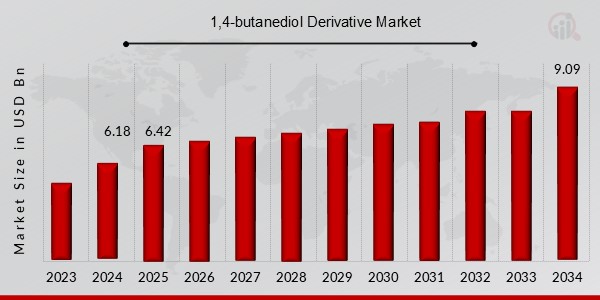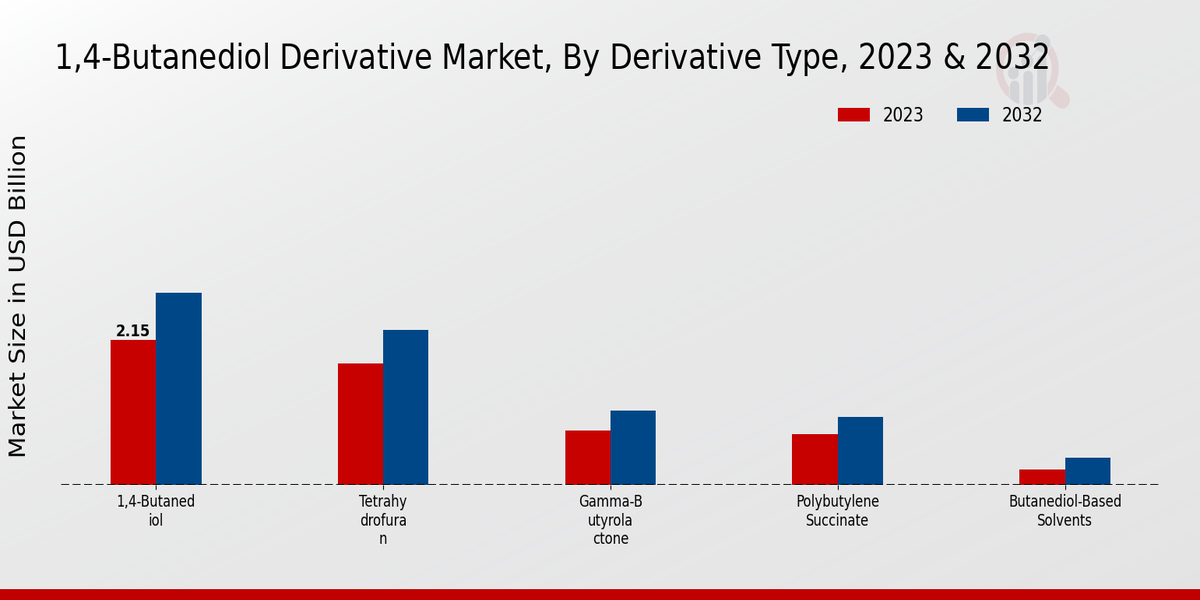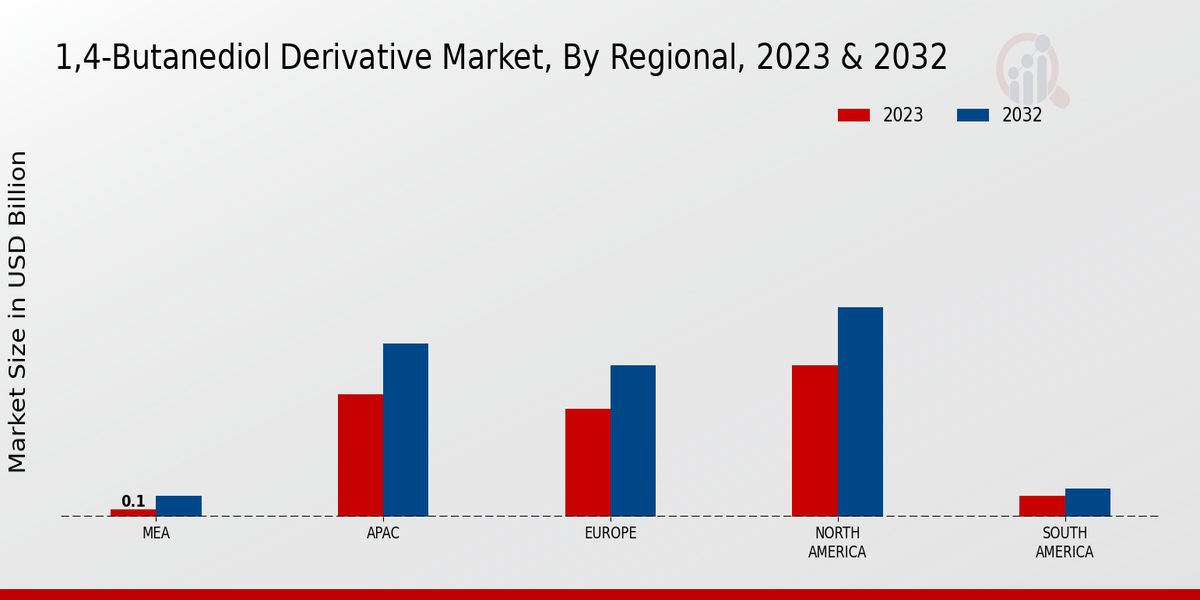Global 1,4-butanediol Derivative Market Overview
The 1 4 Butanediol Derivative Market Size was estimated at 6.18 (USD Billion) in 2024. 1 4 Butanediol Derivative Industry is expected to grow from 6.42 (USD Billion) in 2025 to 9.09 (USD Billion) by 2034, at a CAGR (growth rate) is expected to be around 3.94% during the forecast period (2025 - 2034)
Key 1,4-butanediol Derivative Market Trends Highlighted
The 1,4-butanediol derivative market is experiencing significant growth due to several key market drivers. One major factor is the increasing demand for materials that can provide enhanced performance in various applications.
Industries such as automotive, textiles, and pharmaceuticals require high-quality intermediates and polymers, which are often derived from 1,4-butanediol.
The rise in environmentally friendly production processes is also pushing manufacturers to adopt these derivatives as sustainability becomes a greater consideration in production and consumption patterns. There are numerous opportunities to be explored within this market.
Innovations in technology can lead to more efficient methods of producing 1,4-butanediol derivatives, which can reduce costs and increase output quality. Additionally, the growing trend toward bio-based alternatives offers the potential for companies to create products that meet consumer demands for sustainability without sacrificing performance.
This aligns well with movements toward greener manufacturing and product lifecycle considerations, creating a favorable environment for market entry and expansion.
In recent times, the market has seen shifts that indicate changing preferences among consumers and industries. A move towards biodegradable and non-toxic materials has led to increasing investments in research and development for new applications of 1,4-butanediol derivatives.
Companies are focusing on product differentiation and exploring niche markets, which reflect a trend toward customization in response to specific consumer needs.
Moreover, collaborations and partnerships within the supply chain are gaining traction as organizations seek to enhance their capabilities while meeting regulatory requirements related to toxicity and environmental impact.
A collective shift towards digitalization is also impacting logistical efficiency and market outreach strategies, further shaping the landscape of the 1,4-butanediol derivative market.

Source: Primary Research, Secondary Research, Market Research Future Database and Analyst Review
1,4-butanediol Derivative Market Drivers
-
Increasing Demand from End-Use Industries
The 1,4-butanediol derivative market is experiencing significant growth due to the increasing demand from various end-use industries such as automotive, textiles, and electronics. As manufacturing processes evolve, the need for high-performance materials that can enhance product durability and efficiency becomes paramount.
For instance, in the automotive sector, there is a rising inclination towards lightweight and environmentally friendly materials to improve fuel efficiency and reduce carbon emissions. Similarly, the textile industry is focusing on producing high-quality synthetic fibers that can withstand rigorous use and provide comfort.
This trend is also mirrored in the electronics sector, where advanced materials are crucial for producing compact, high-performance devices. The diverse applications of 1,4-butanediol derivatives are making them essential in developing more energy-efficient and environmentally sustainable products.
With the overall market valuation projected to grow steadily in the coming years, investment in innovation and sustainable practices by manufacturers will likely lead to further expansion of the 1,4-butanediol derivative market, driving demand for these derivatives in both established and emerging markets.
Technological Advancements in Production Processes
Innovation plays a crucial role in the 1,4-butanediol derivative market as advancements in production processes lead to improved yield and reduced production costs.
Enhanced techniques such as catalytic methods and green chemistry are being adopted, which not only optimize the efficiency of 1,4-butanediol derivatives but also minimize the environmental impact. The shift towards more sustainable and efficient production methods is essential as industries face increasing regulations regarding environmental performance.
Consequently, companies that invest in these new technologies are better positioned to meet the rising demand while adhering to stricter guidelines. With an upswing in production efficiencies, the 1,4-butanediol derivative market is set to benefit from lower costs and increased profitability.
Growing Awareness for Sustainable Solutions
As consumers and industries worldwide become more conscious of their ecological footprint, the demand for sustainable products is rising.
The 1,4-butanediol derivative market is directly influenced by this trend, as many manufacturers are looking to incorporate biodegradable and eco-friendly materials in their product lines. The development of bio-based alternatives to conventional 1,4-butanediol has garnered attention, providing a more sustainable option for industries dependent on these derivatives.
This shift towards sustainable practices is not only expected to appeal to environmentally conscious consumers but also position companies favorably in a market that increasingly values sustainability. The market is thus on the brink of further expansion as it aligns with sustainability goals.
1,4-butanediol Derivative Market Segment Insights
1,4-butanediol Derivative Market Derivative Type Insights
The market encompasses various derivative types, including 1,4-butanediol, Tetrahydrofuran, Gamma-butyrolactone, Polybutylene succinate, and Butanediol-based solvents, each contributing distinctively to the overall market dynamics.
The most significant segment, 1,4-butanediol, showed a valuation of 2.15 USD billion in 2023, projected to increase to 2.85 USD billion by 2032, thus maintaining a majority holding within the market, primarily due to its widespread application in pharmaceuticals, plastics, and textiles.
Tetrahydrofuran stood as another key segment with a value of 1.8 USD billion in 2023, expected to rise to 2.3 USD billion by 2032; this sector enjoys significant demand as it is pivotal in producing various polymers and resins, thereby strengthening its importance in the market structure.
Gamma-butyrolactone, valued at 0.8 USD billion in 2023 and projected to grow to 1.1 USD billion in 2032, serves a vital role in solvent applications, showcasing a steady momentum due to increasing needs in the agrochemical and electronic industries.
The Polybutylene succinate segment, valued at 0.75 USD billion in 2023 with a rise anticipated to 1.0 USD billion by 2032, is distinguished by its biodegradable properties, making it significant in the growing demand for sustainable materials.
However, Butanediol-based solvents, while currently valued at 0.22 USD billion in 2023 and projected to reach 0.4 USD billion by 2032, remains the least dominant segment, owing to its niche applications compared to other derivatives.
The segmentation of the 1,4-butanediol derivative market reveals the diverse applications and the competitive positioning of each derivative type, emphasizing the varying degrees of market influence and growth potential across different industries, transforming the landscape into a robust arena for innovation and expansion.
 Source: Primary Research, Secondary Research, MRFR Database and Analyst Review
Source: Primary Research, Secondary Research, MRFR Database and Analyst Review
1,4-butanediol Derivative Market Application Insights
The segment is crucial, witnessing various industries adopt 1,4-butanediol derivatives for diverse applications. The textiles industry notably exemplifies a significant user, relying on these derivatives for the production of fibers and textiles that offer enhanced durability and performance.
Furthermore, the automotive sector also plays a vital role, utilizing 1,4-butanediol derivatives in manufacturing high-performance materials, which contribute to weight reduction and improved fuel efficiency.
Pharmaceuticals stand out as another prominent application, leveraging these derivatives for the synthesis of essential drugs and intermediates, reflecting their importance in healthcare. In the cosmetics industry, 1,4-butanediol derivatives are increasingly used for producing skin care products that provide moisturizing and volumizing effects.
Lastly, the plastics sector dominates the market by incorporating these chemicals into the production of various plastic materials, enhancing properties such as flexibility and longevity.
1,4-butanediol Derivative Market Functionality Insights
The segment plays a significant role in various end-use industries, driven primarily by the demand for solvents, intermediate chemicals, plasticizers, and additives. Solvents, which are crucial for numerous applications, dominate the market due to their versatility and necessity in manufacturing processes.
Intermediate chemicals are also vital as they act as building blocks in the production of diverse chemical products.
Plasticizers contribute notably to enhancing the flexibility and durability of plastics, thus finding substantial use in the polymer industry. Meanwhile, additives are increasingly recognized for improving product performance and stability.
The 1,4-butanediol derivative market statistics point to a steady market growth trajectory, bolstered by the expanding applications across sectors such as automotive, textiles, and pharmaceuticals, which are continuously seeking innovative solutions and materials, thereby providing ample opportunities for firms operating within this competitive market landscape.
1,4-butanediol Derivative Market End User Industry Insights
The chemical manufacturing sector holds a major share of this market, leveraging 1,4-butanediol derivatives for the production of various chemicals and polymers, thereby driving robust demand.
Consumer goods also play a crucial role, as these derivatives are key components in a variety of everyday products, enhancing their functionality. The automotive industry uses these derivatives in manufacturing parts and materials, which are essential for improving vehicle durability and performance.
Likewise, the healthcare sector benefits from 1,4-butanediol derivatives, utilized in the production of medical devices and pharmaceuticals, ensuring better patient care and innovative treatments. The textile industry incorporates these derivatives for improved fabric properties, making it a significant contributor to market growth.
Overall, the 1,4-butanediol derivative market segmentation illustrates the importance of these end-user industries in driving demand and influencing market trends. As the market evolves, it faces challenges, including environmental regulations and raw material costs, but presents substantial opportunities for innovation and expansion in various applications
1,4-butanediol Derivative Market Regional Insights
Among the regions, North America stood out with a significant valuation of 2.1 USD billion, showcasing its dominance in the market. Meanwhile, the Asia Pacific region is valued at 1.7 USD billion, contributing substantially and reflecting its rapidly growing industrial applications and demand for derivatives.
Europe was also placed prominently with a valuation of 1.5 USD billion, driven by the increasing demand from automotive and consumer goods sectors.
South America and the Middle East and Africa held smaller market shares with 0.3 USD billion and 0.1 USD billion in 2023, respectively, indicating more emerging opportunities. By 2032, market trends predicted a gradual increase across all regions, with North America expected to reach 2.9 USD billion while Asia Pacific could see an increase to 2.4 USD billion.
Each region presents unique opportunities and challenges influenced by local industry needs, regulatory landscapes, and economic conditions, essential for understanding the broader 1,4-butanediol derivative market segmentation data and statistics.
 Source: Primary Research, Secondary Research, MRFR Database and Analyst Review
Source: Primary Research, Secondary Research, MRFR Database and Analyst Review
1,4-butanediol Derivative Market Key Players and Competitive Insights
The 1,4-butanediol derivative market is characterized by a dynamic interplay of various factors that shape its competitive landscape. This market is influenced by diverse applications ranging from textiles to pharmaceuticals, fueling a robust demand for 1,4-butanediol derivatives.
Companies operating within this space must navigate through fluctuating raw material prices, evolving regulatory requirements, and increasing environmental concerns.
As competition intensifies, firms are leveraging innovative technologies and enhancing their production capabilities to maintain market relevance. Strategic partnerships and mergers are also commonplace strategies to capture greater market share and diversify product offerings.
Kraton Corporation has made substantial inroads within the 1,4-butanediol derivative market, primarily through its focus on high-performance materials. The company's strengths lie in its advanced research and development capabilities, which allow it to produce specialized derivatives that meet the specific needs of various industries.
Kraton Corporation excels in leveraging its extensive distribution network, ensuring timely delivery of its products while maintaining high-quality standards.
Their commitment to sustainable practices and environmentally friendly production methods further solidifies their competitive edge, as consumers increasingly prefer eco-conscious products. By investing in innovation and efficiency, Kraton Corporation continues to enhance its position in the market, responding proactively to trends and customer demands.
Formosa Plastics has established a strong foothold in the 1,4-butanediol derivative market, known for its significant production capacity and broad portfolio of chemical products. The company's competitive strengths are rooted in its robust manufacturing processes, which enhance operational efficiency and reduce costs.
Formosa Plastics benefits from economies of scale, allowing it to compete aggressively on price while maintaining quality. With a focus on innovation, the company actively invests in research and development to explore new applications and formulations for its 1,4-butanediol derivatives.
Moreover, Formosa Plastics places great emphasis on compliance with regulatory standards, ensuring that its operations meet both safety and environmental guidelines. This commitment not only bolsters their market reputation but also positions them favorably in an industry that is increasingly scrutiny for environmental impact.
Key Companies in the 1,4-butanediol derivative market Include
1,4-butanediol Derivative Market Developments
Recent developments in the 1,4-butanediol derivative market highlight a growing trend towards sustainable production practices and investments in innovative applications. Companies like BASF and DOW are expanding their portfolios to include bio-based 1,4-butanediol derivatives.
In current affairs, the market is witnessing a surge in demand for textiles and plastics, driven by the increasing adoption of environmentally friendly materials. Furthermore, mergers and acquisitions are shaping the landscape; for instance, the acquisition of a significant stake by Evonik into a key competitor is poised to enhance market positioning and capabilities.
These dynamics not only indicate a healthy competitive environment but also underscore the impact of innovation and sustainability in meeting evolving consumer expectations and regulatory requirements.
1,4-butanediol Derivative Market Segmentation Insights
1,4-butanediol Derivative Market Derivative Type Outlook
1,4-butanediol Derivative Market Application Outlook
1,4-butanediol Derivative Market Functionality Outlook
1,4-butanediol Derivative Market End User Industry Outlook
1,4-butanediol Derivative Market Regional Outlook
|
Report Attribute/Metric
|
Details
|
|
Market Size 2024
|
6.18 (USD Billion)
|
|
Market Size 2025
|
6.42 (USD Billion)
|
|
Market Size 2034
|
9.09 (USD Billion)
|
|
Compound Annual Growth Rate (CAGR)
|
3.94% (2025 - 2034)
|
|
Report Coverage
|
Revenue Forecast, Competitive Landscape, Growth Factors, and Trends
|
|
Base Year
|
2024
|
|
Market Forecast Period
|
2025 - 2034
|
|
Historical Data
|
2020 - 2024
|
| Market Forecast Units |
USD billion |
| Key Companies Profiled |
Kraton Corporation, Formosa Plastics, Repsol, Invista, Ashland, Eastman Chemical, Dairen Chemical, Sabic, BASF, Samsung Fine Chemicals, Ningbo Jiangning Chemical, Mitsui Chemicals, LyondellBasell, Huntsman Corporation, Mitsubishi Chemical |
| Segments Covered |
Derivative Type, Application, Functionality, End User Industry, Regional |
| Key Market Opportunities |
Increasing demand for automotive applications Growth in the sustainable textiles market Expansion in pharmaceuticals and cosmetics Rising demand for biodegradable plastics Adoption in advanced manufacturing processes |
| Key Market Dynamics |
Increasing demand in various industries Sustainable production methods adoption Price volatility of raw materials Regulatory compliance challenges Growing applications in plastics |
| Countries Covered |
North America, Europe, APAC, South America, MEA |






 Source: Primary Research, Secondary Research, MRFR Database and Analyst Review
Source: Primary Research, Secondary Research, MRFR Database and Analyst Review Source: Primary Research, Secondary Research, MRFR Database and Analyst Review
Source: Primary Research, Secondary Research, MRFR Database and Analyst Review







